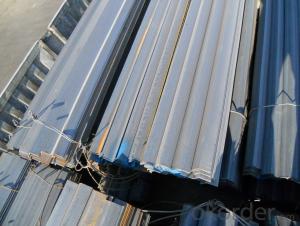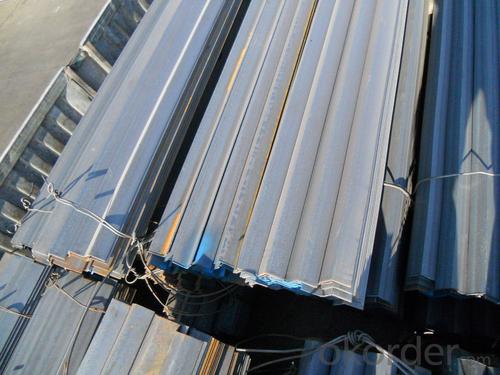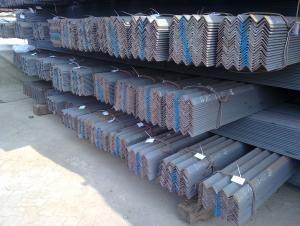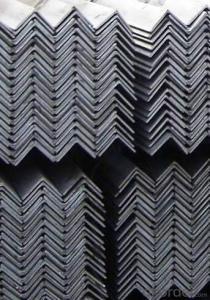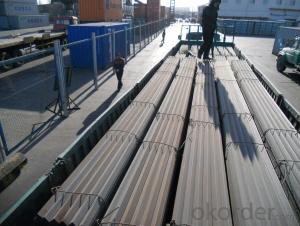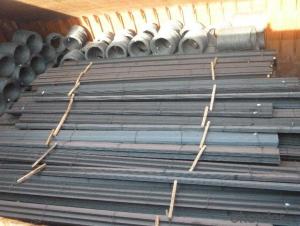Hot Rolled Steel Angle Bar Equal Angle Bar Unequal Angle Bar GB/JIS/ASTM/DIN
- Loading Port:
- Tianjin
- Payment Terms:
- TT OR LC
- Min Order Qty:
- 50 m.t.
- Supply Capability:
- 10000 m.t./month
OKorder Service Pledge
OKorder Financial Service
You Might Also Like
Specification
Product Description:
OKorder is offering Hot Rolled Steel Angle Bar Equal Angle Bar Unequal Angle Bar GB/JIS/ASTM/DIN at great prices with worldwide shipping. Our supplier is a world-class manufacturer of steel, with our products utilized the world over. OKorder annually supplies products to European, North American and Asian markets. We provide quotations within 24 hours of receiving an inquiry and guarantee competitive prices.
Product Applications:
Hot Rolled Steel Angle Bar Equal Angle Bar Unequal Angle Bar GB/JIS/ASTM/DIN are ideal for structural applications and are widely used in the construction of buildings and bridges, and the manufacturing, petrochemical, and transportation industries.
Product Advantages:
OKorder's Hot Rolled Steel Angle Bar Equal Angle Bar Unequal Angle Bar GB/JIS/ASTM/DIN are durable, strong, and resist corrosion.
Main Product Features:
· Premium quality
· Prompt delivery & seaworthy packing (30 days after receiving deposit)
· Corrosion resistance
· Can be recycled and reused
· Mill test certification
· Professional Service
· Competitive pricing
Product Specifications:
Chinese Standard (H*W*T) | Weight (Kg/m) | 6m (pcs/ton) | Light I (H*W*T) | Weight (Kg/m) | 6m (pcs/ton) | Light II (H*W*T) | Weight (Kg/m) | 6M |
100*68*4.5 | 11.261 | 14.8 | 100*66*4.3 | 10.13 | 16.4 | 100*64*4 | 8.45 | 19.7 |
120*74*5.0 | 13.987 | 11.9 | 120*72*4.8 | 12.59 | 13.2 | 120*70*4.5 | 10.49 | 15.8 |
140*80*5.5 | 16.89 | 9.8 | 140*78*5.3 | 15.2 | 10.9 | 140*76*5 | 12.67 | 13.1 |
160*88*6 | 20.513 | 8.1 | 160*86*5.8 | 18.46 | 9 | 160*84*5.5 | 15.38 | 10.8 |
180*94*6.5 | 24.143 | 6.9 | 180*92*6.3 | 21.73 | 7.6 | 180*90*6 | 18.11 | 9.2 |
200*100*7 | 27.929 | 5.9 | 200*98*6.8 | 25.14 | 6.6 | 200*96*6.5 | 20.95 | 7.9 |
220*110*7.5 | 33.07 | 5 | 220*108*7.3 | 29.76 | 5.6 | 220*106*7 | 24.8 | 6.7 |
250*116*8 | 38.105 | 4.3 | 250*114*7.8 | 34.29 | 4.8 | 250*112*7.5 | 28.58 | 5.8 |
280*122*8.5 | 43.492 | 3.8 | 280*120*8.2 | 39.14 | 4.2 | 280*120*8 | 36.97 | 4.5 |
300*126*9 | 48.084 | 3.4 | 300*124*9.2 | 43.28 | 3.8 | 300*124*8.5 | 40.87 | 4 |
320*130*9.5 | 52.717 | 3.1 | 320*127*9.2 | 48.5 | 3.4 | |||
360*136*10 | 60.037 | 2.7 | 360*132*9.5 | 55.23 | 3 |
Packaging & Delivery of Angle Steel
1. Transportation: the goods are delivered by truck from mill to loading port, the maximum quantity can be loaded is around 40MTs by each truck. If the order quantity cannot reach the full truck loaded, the transportation cost per ton will be little higher than full load.
2. With bundles and load in 20 feet/40 feet container, or by bulk cargo, also we could do as customer's request.
3. Marks:
Color mark: There will be color marking on both end of the bundle for the cargo delivered by bulk vessel. That makes it easily to distinguish at the destination port.
Tag mark: There will be tag mark tied up on the bundles. The information usually including supplier logo and name, product name, made in China, shipping marks and other information request by the customer.
If loading by container the marking is not needed, but we will prepare it as customer request.
FAQ:
Q1: Why buy Materials & Equipment from OKorder.com?
A1: All products offered byOKorder.com are carefully selected from China's most reliable manufacturing enterprises. Through its ISO certifications, OKorder.com adheres to the highest standards and a commitment to supply chain safety and customer satisfaction.
Q2: How do we guarantee the quality of our products?
A2: We have established an advanced quality management system which conducts strict quality tests at every step, from raw materials to the final product. At the same time, we provide extensive follow-up service assurances as required.
Q3: How soon can we receive the product after purchase?
A3: Within three days of placing an order, we will begin production. The specific shipping date is dependent upon international and government factors, but is typically 7 to 10 workdays.
Q4: What makes stainless steel stainless?
A4: Stainless steel must contain at least 10.5 % chromium. It is this element that reacts with the oxygen in the air to form a complex chrome-oxide surface layer that is invisible but strong enough to prevent further oxygen from "staining" (rusting) the surface. Higher levels of chromium and the addition of other alloying elements such as nickel and molybdenum enhance this surface layer and improve the corrosion resistance of the stainless material.
Q5: Can stainless steel rust?
A5: Stainless does not "rust" as you think of regular steel rusting with a red oxide on the surface that flakes off. If you see red rust it is probably due to some iron particles that have contaminated the surface of the stainless steel and it is these iron particles that are rusting. Look at the source of the rusting and see if you can remove it from the surface.
Images:

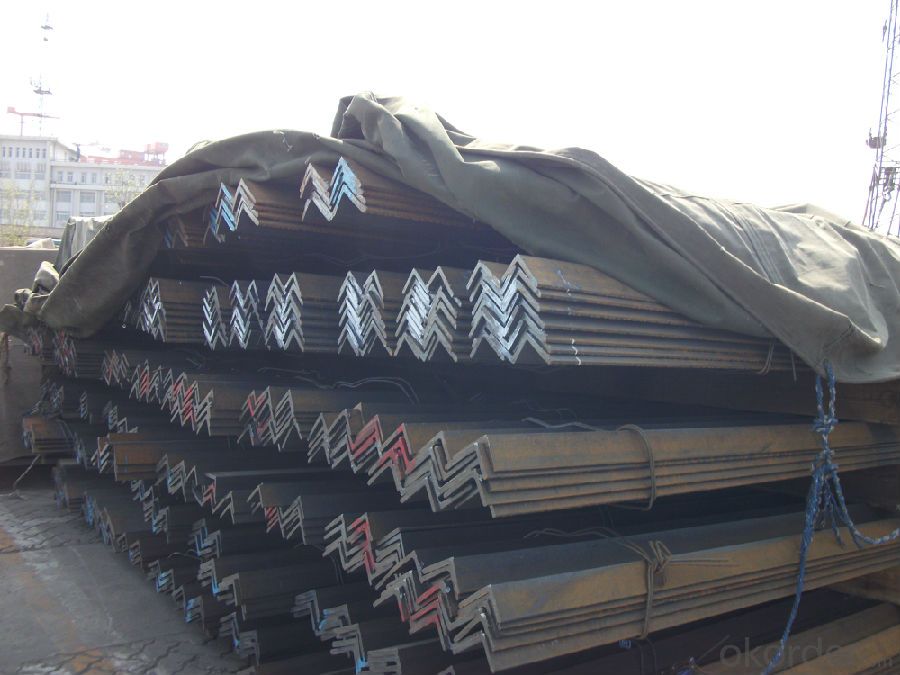
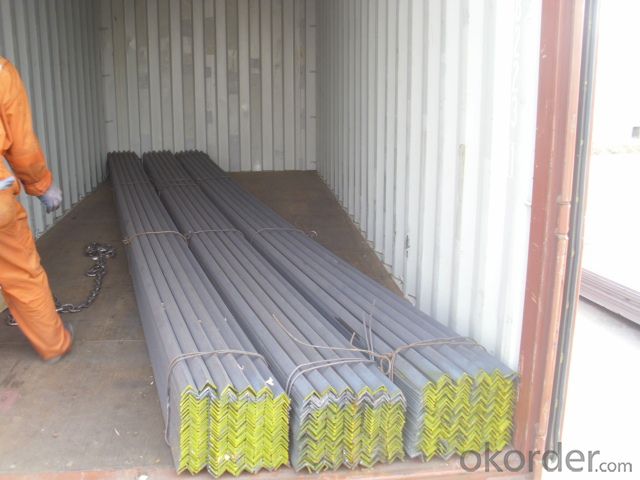
- Q: How do steel angles contribute to sustainable transportation infrastructure?
- Steel angles contribute to sustainable transportation infrastructure in several ways. Firstly, steel angles are a key component in the construction of bridges and highways. Their strength and durability make them ideal for supporting heavy loads and withstanding the harsh conditions that transportation infrastructure is exposed to. This means that structures built with steel angles have a longer lifespan, reducing the need for frequent repairs or replacements. This not only saves money but also reduces the environmental impact associated with the production and disposal of construction materials. Additionally, using steel angles in the construction of transportation infrastructure allows for more efficient designs. The versatility of steel angles enables engineers to create innovative and lightweight structures that require less material overall. This results in reduced energy consumption during the construction process and decreased emissions during transportation and installation. Furthermore, steel angles are recyclable. At the end of their lifespan, they can be easily recycled and used to manufacture new steel products. This reduces the demand for raw materials and minimizes waste sent to landfills. The recycling process also requires less energy and emits fewer greenhouse gases compared to the production of new steel, making it an environmentally friendly choice. Moreover, steel angles can contribute to sustainable transportation infrastructure by facilitating the integration of sustainable technologies. For example, they can be used to support solar panels or wind turbines, enabling the generation of clean energy to power transportation systems. By incorporating renewable energy sources into infrastructure projects, the reliance on fossil fuels can be reduced, leading to a decrease in greenhouse gas emissions and a more sustainable transportation system. In conclusion, steel angles play a crucial role in sustainable transportation infrastructure. Their strength, durability, recyclability, and ability to support sustainable technologies make them an environmentally friendly choice. By using steel angles in the construction of bridges, highways, and other transportation structures, we can create a more sustainable and resilient transportation system that reduces the environmental impact and promotes a greener future.
- Q: Are steel angles suitable for supporting rooftop equipment?
- Yes, steel angles are suitable for supporting rooftop equipment. Steel angles offer sturdy support and can withstand the weight and stress of rooftop equipment, making them a reliable choice for this purpose.
- Q: What is the cost of a steel angle?
- The cost of a steel angle can vary depending on several factors such as the size, grade, thickness, and the supplier or manufacturer. Generally, steel angles are priced per length or per weight. It is important to consider the market conditions, location, and the specific requirements of the steel angle needed when determining the cost. It is recommended to contact local suppliers or manufacturers for accurate and up-to-date pricing information.
- Q: How do steel angles contribute to the seismic resilience of a structure?
- Steel angles are an essential component in enhancing the seismic resilience of a structure. These angled steel members are commonly used in construction to provide additional strength and stability, particularly in earthquake-prone areas. One way steel angles contribute to the seismic resilience of a structure is through their ability to resist lateral forces caused by seismic activities. During an earthquake, buildings are subjected to horizontal forces that can cause significant damage. Steel angles are strategically placed within the structure to help distribute and dissipate these forces, thus reducing the overall impact on the building. By acting as braces or stiffeners, steel angles enhance the structural integrity and prevent excessive deformation or collapse. Furthermore, steel angles are often used in conjunction with other seismic design strategies, such as moment frames or shear walls. These elements work together to create a robust and flexible structural system that can withstand the dynamic forces generated during an earthquake. Steel angles are typically integrated into these systems to provide additional reinforcement and increase the overall strength and rigidity of the structure. In addition to their role in resisting lateral forces, steel angles also contribute to the seismic resilience of a structure by improving its load-carrying capacity. By distributing loads more efficiently, steel angles help to reduce the stress on individual components, preventing localized failures and ensuring the overall stability of the structure. Moreover, steel angles are highly durable and possess excellent material properties, such as high tensile strength and toughness. This makes them well-suited for withstanding the dynamic loading and cyclic motions associated with earthquakes. Steel angles are also resistant to corrosion, which is crucial for maintaining the long-term structural integrity and overall performance of a building in seismic events. In conclusion, steel angles play a crucial role in enhancing the seismic resilience of a structure. By resisting lateral forces, improving load-carrying capacity, and providing durability, they contribute to the overall stability and integrity of the building. Incorporating steel angles into the design and construction process is essential for creating structures that can withstand seismic activities and ensure the safety of occupants.
- Q: How do steel angles contribute to the resiliency of a structure?
- Steel angles contribute to a structure's resiliency in multiple ways. Firstly, they distribute the load across different members, providing added structural support and stability. In construction projects, steel angles are often used as reinforcements or braces, enabling the transmission of forces and preventing excessive deflection or deformation. This helps the structure resist external forces like wind, earthquakes, or heavy loads, ultimately enhancing its overall resilience. Furthermore, steel angles possess high durability and corrosion resistance, further bolstering a structure's resiliency. Steel, as a material, boasts exceptional strength and longevity, making it particularly well-suited for enduring harsh environmental conditions and potential structural failures. This durability ensures the structure can withstand the test of time, reducing the need for frequent repairs or replacements and ultimately improving its overall resilience. Additionally, steel angles offer flexibility in design and construction, facilitating efficient load transfer and optimized structural configurations. They can be easily customized and fabricated to meet specific project requirements, guaranteeing the structure can be tailored to withstand various dynamic and static loads. This adaptability enhances the structure's resiliency by enabling it to adapt to changing conditions or future modifications. In summary, steel angles play a vital role in enhancing a structure's resiliency by providing additional support, durability, and flexibility. Their ability to distribute loads, resist external forces, and withstand harsh conditions ensures the structure can withstand unexpected events and maintain its integrity. As such, steel angles are an indispensable component of resilient construction practices.
- Q: How do steel angles contribute to the sustainability of a project?
- Steel angles contribute to the sustainability of a project in several ways. Firstly, they are made from recycled steel, reducing the demand for new raw materials and promoting a circular economy. Secondly, steel angles have a high strength-to-weight ratio, allowing for lighter and more efficient structural designs, which in turn reduces the amount of steel required and minimizes the carbon footprint of the project. Lastly, steel angles are durable, resistant to corrosion, and have a long lifespan, ensuring the longevity and sustainability of the structure they support.
- Q: Can steel angles be used for green building projects?
- Yes, steel angles can be used for green building projects. Steel is a highly sustainable and recyclable material that can be used in various structural applications. Steel angles provide strength and stability, making them suitable for constructing green buildings that prioritize energy efficiency, durability, and environmental sustainability.
- Q: Are steel angles resistant to termites and pests?
- No, steel angles are not resistant to termites and pests. Steel angles, being made of metal, are not attractive to termites as they do not provide a food source. However, termites can still cause damage to surrounding materials such as wood or insulation, which may be present in the structure where the steel angles are used. It is important to ensure that the overall construction is termite-resistant and appropriate measures are taken to prevent infestations.
- Q: Can steel angles support heavy machinery or equipment?
- Yes, steel angles can support heavy machinery or equipment. Steel angles are commonly used in construction and engineering due to their strength and durability. They are typically made from hot-rolled steel and can withstand heavy loads and forces. Steel angles provide structural support and stability, making them suitable for supporting heavy machinery or equipment. They are often used as frames or brackets to hold and secure heavy objects. Additionally, steel angles can be welded or bolted together to create a strong and stable base for heavy machinery. Overall, steel angles are a reliable choice for supporting heavy machinery or equipment due to their high load-bearing capacity and structural integrity.
- Q: How do you prevent welding distortion in steel angles?
- There are several ways to prevent welding distortion in steel angles. One common method is to use tack welds to hold the pieces in place before making the final welds. This helps to distribute the heat more evenly and reduce the chances of distortion. Additionally, using a smaller welding electrode or reducing the welding current can also help minimize distortion. Another technique is to weld in a staggered pattern, alternating between the top and bottom sides of the angle, which can help to balance the thermal effects. Lastly, controlling the preheating and cooling rates, as well as implementing proper welding sequence and clamping techniques, can further reduce welding distortion in steel angles.
Send your message to us
Hot Rolled Steel Angle Bar Equal Angle Bar Unequal Angle Bar GB/JIS/ASTM/DIN
- Loading Port:
- Tianjin
- Payment Terms:
- TT OR LC
- Min Order Qty:
- 50 m.t.
- Supply Capability:
- 10000 m.t./month
OKorder Service Pledge
OKorder Financial Service
Similar products
Hot products
Hot Searches
